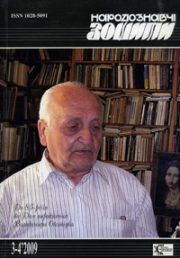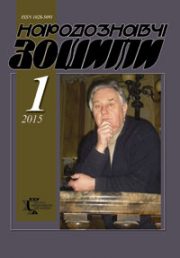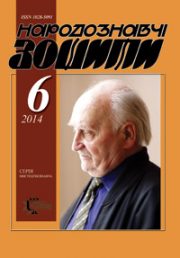The Ethnology Notebooks. 2023. № 6 (174), 1450—1458
UDK 39(4=292.451/.454):303.683
DOI https://doi.org/10.15407/nz2023.06.1450
REGIONAL FEATURES OF CARPATHIAN FOLKLORE IN THE CONTEXT OF POPULATION GENETICS
DAVYDIUK Viktor
- ORCID ID: https://orcid.org/0000-0001-9019-0466
- Doctor of Philology, Professor,
- The Departament of Ukrainian Literature
- Lesya Ukrainka Volyn National University,
- 13 Volya Avenue, Lutsk, 43025, Ukraine,
- Contacts: e-mail: totem2004@bigmir.net
Abstract. The folklore of the Ukrainian Carpathians is so peculiar that researchers often had doubts about its Ukrainian origin. The search for matches among the nearest neighbors also did not yield results. Therefore, the roots of these differences should be sought in the genesis of these phenomena.
The author sees the reason for the absence of many typical for Ukrainian folklore phenomena in the Carpathian folklore tradition in the geographical location and peculiarities of the settlement of the region since the Neolithic times, when some folklore phenomena were just being formed.
According to DNA data, the population of the Carpathians has a significant genetic connection with people from the Balkans and the Libyan desert in the territory of modern Egypt, which was fertile once. That is why the ritual and folklore tradition of the region has many similarities with the peoples of the Mediterranean basin: Albanians, Greeks, Macedonians, northern Italians. These features were formed before the emergence of these peoples and their languages. Subsequent demographic processes led to the fact that the Indo-Europeanized and Slavicized population of the Ukrainian Carpathians is represented by the same DNA haplogroups as other Ukrainians, only in other proportions, has a different folklore tradition, the originality of which indicates its pre-Ukrainian and even pro-Slavic origin.
The intelligence methodology is based on general scientific methodological principles and the main requirements for works of historical and ethnological direction.
Keywords: Boykos, Lemkos, Hutsuls, ceremonial folklore, «korochun», «ladkanki», «oblivanka», kolomyykovy system, Kupala folklore, ethnohistory, DNA genealogy.
Received 6.11.2023
REFERENCES
- Hnatiuk, V. (1924). Gutsuli. Subcarpathian Rus, 2, 48 [in Ukrainian].
- Kyrchiv, R. (2002). From folkloristic regions of Ukraine. Lviv [in Ukrainian].
- Waigel, L. (1887). About Gucul. Ethnographic outline. Pamietnik Towarzystwa Tatrzanskiego. Diary of the Tatra Society (Vol. 11). Krakow [in Polish].
- Prokopiv, I. Hutsul wedding in the village of Kosmachi, Kosiv district. Institute of Art History. Folklore and Ethnology. Department of Manuscript Funds. F. 14—3. № 492 [in Ukrainian].
- Toronskyi, A. (1860). Rusyns-Lemki. Dawn of Galicia an album for the year 1860 (Pp. 412—413) [in Ukrainian].
- Holovatskyi, Ya. (1878). Folk songs of the Galician and Ugric Rus (Part III, sep. 2, p. 7). Moscow [in Russian].
- Peniak, P. (2006). Archaeological antiquities in the construction of historical and cultural monuments of the Transcarpathian region. Materials and research on the archeology of Prykarpattia and Volyn (Issue 10, pp. 272—276) [in Ukrainian].
- Davydiuk, V. (2019). All year (reach the field of calendar ceremonies of the Zakhidny Polisya). Lutsk [in Ukrainian].
- Davydiuk, V. (2005). Ethnological sketch of Volyn. Lutsk [in Ukrainian].
- Haak et al. (2005). Ancient DNA from the First European Farmers in 7500-Years-Old Neolitic Sites. Science, 10, 1016—1018.
- Korolyuk, V. (1985). Slavic and Vlachs in the early Middle Ages. Political and ethnic history. Moscow: Nauka [in Russian].
- Tolochko, P. (2005). Old Russian Nationality: Imaginary or real. St. Peterubrg [in Russian].
- Melnyk, V. (2013). Anthropological typology of a long-standing Ukrainian population in ethno-historical context. Bulletin of Vinnytsia National Medical University, 2 (Vol. 17, pp. 345—357) [in Ukrainian].
- Davydiuk, V. (2013). The rite of causing rain in European countries (genetic aspect). Literature. Folklore. Problems of poetics (Issue 38, pp. 72—84) [in Ukrainian].
- Carpatho-Rusyn Heritage DNA Project. Retrieved from: www.familytreedna.com/public/carpatho-rusyn/default.aspx?section=yresults Carpatho-Rusyn Heritage DNA Project, Y-DNA results
- ESUM — Etymological dictionary of Ukrainian movy (Vol. 3, p. 80) [in Ukrainian].
- Y-DNA among the peoples of the world. Retrieved from: https://ru.wikipedia.org/wiki/Гаплогруппы_Y-ДНК_среди_народов_мира
- Kaharov, Ye. (2020). Forms and elements of folk rites. Reprint edition. Kyiv [in Ukrainian].
- Willis, C. (2006). Study of the Human Mitochondrial DNA Polymorphism. McNair Scholars Journal: GVSU McNair Scholars Journal (Vol. 10, pp. 107—114).
- Nikitin, A. et al. (2009, march). Mitochondrial DNA Sequence Variation in the (2009). Boyko, Hutsul, and Lemko Populations of the Carpathian Highlands. Human Biology, 81 (1), 43—58.
- Basque_mythology. Retrieved from: https://ru.wikipedia.org/wiki/Баскская_мифология
- Ottoni C, et al. (2010). Mitochondrial Haplogroup H1 in North Africa: An Early Holocene Arrival from Iberia. PLoS ONE 5 (10): e13378. Retrieved from: https://doi.org/10.1371/journal.pone.0013378
- Zaporozhchenko, V. (Ed.). (2011, 05.08.). Haplogroup Ages. Human mtDNA (Build 4).
- Loogvali, et al. (2004). Disuniting Uniformity: A Pied Cladistic Canvas of mtDNA Haplogroup H in Eurasia. Society for Molecular Biology and Evolution, 2004.
- Davydiuk, V. (2008). Kupala, bathed, de te winter. Polissya home (Issue 3, pp. 45—103).Lutsk [in Ukrainian].
- Pamfile, Tudor. (1910). Sarbatorile de тага le romani. Bucuresti [in Romanian].
- Hoshovskyi, V. (1971). In the wake of a wedding song of the Slavs. At the origins of folk music of the Slavs (Pp. 50—80). Moscow: Soviet composer [in Russian].
- (2002). Lemkivshchyna (Vol. 2: Spiritual Culture). Lviv [in Ukrainian].
- Pelyna, Н. Traditional wedding rituals of the Tyachevsky district of the Transcarpathian region. Tradition and the present, 12, 233—243 [in Russian].
- Utevskaia, О. et al. (2013). Similarity of Ukrainian populations from different territorial subdivisions on Y-chromosome markers. Factors of experimental evolution of organisms (Vol. 13, pp. 338—341). Retrieved from: http://nbuv.gov.ua/UJRN/feeo_2013_13_88
- YHRD Population ID 597. Uzhgorod.







